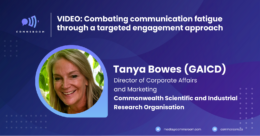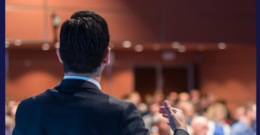We are not in any way exaggerating when we say that the communications landscape has changed a LOT over the decade, especially during and after the pandemic when almost everything turned virtual.
Artificial intelligence and virtual reality are slowly taking over different facets of the world, communications-wise and in general.
Today, we’re consulting with a communications expert to gain insights on what the future might look like with all these advancements in the way we do communications.
This communications pro is Sarah Gates, who’s excited to take on her new role with different people, stories, strengths and processes at the RMIT University as Communications Manager, External Affairs and Media.
Gates said, “What I’ve found in just my first few weeks at RMIT is their profound commitment to impact.
“We’re not just measuring the success of media and communications through media reach or share of voice—we want our researchers to be hearing from new partners, funding bodies, government advisory boards and communities that their work could influence, and we want our students to have an exceptional experience, connected to industry and leading to rewarding careers.”
According to Gates, these things can be hard to quantify, but with RMIT’s team that’s driven towards the same goal, she’s thrilled to have the chance to contribute to that impact.
Read also: Values-driven and outcomes-focused leader Matt Macklin of Swinburne (commsroom.co)

Sharing her observations on the massive shift in the communications landscape, Gates said, “The pandemic accelerated the shift to digital. Some organisations were already conducting hybrid meetings, offering work from home, focusing on digital communications and utilising emerging technologies. Others had to adapt quickly.”
As a process-minded person, Gates was glad to embrace the shift which she claims has made crystal clear how important it is to have smart, agile tools for managing workflows, allowing for hybrid work, tracking and reporting on outcomes, and sharing institutional knowledge.
For someone who’s working at a university of technology, Gates is at the forefront of how these processes can boost productivity and contributing to a high-performing team that continues to find improvements.
“It’s also turbocharged our sustainability efforts—fewer brochures, posters and booklets, replaced by smarter digital options,” Gates said.
But amidst the various emerging types of media that technological advancements have brought to the world, such as Reels, memes and whatnot, Gates does not believe that old ways of delivering communications such as copywriting should be abandoned.
“Good copy underpins so much of marketing and communications. It’s core to communicating your purpose, capturing the attention and hearts of your audience, establishing your brand’s voice, and driving how people experience and interact with the brand,” said Gates, who has been a copywriter since 2014.
You may also want to read: Red Havas’ Matt Thomas on meaningful brand frameworks (commsroom.co)
Gates stresses that “good copywriters can boost sales, transform a brand identity or pull it back from a crisis.”
“With emerging media, comes new copywriting needs. You can spend a lot of money on an ad that uses all the latest data tools; but if the copy isn’t good, it won’t have the result you want. You
might see a company throwing their investment into reels and TikToks, but what you don’t see are the storyboards and scripts behind them,” Gates said.
Gates is also one of the many that still do not get bothered by the potential threat of artificial intelligence software/tools e.g. ChatGPT and CopyAI writer’s jobs.
Gates said that while it’s tempting to think that businesses could outsource some of their writing with the rise of better AI, “there is always more to do than people who can do it. But writers do more than put words on the page.”
“We draw on strategy, build that elusive tone and emotional resonance, tailor copy to the audience, and bring out-of-the-box creativity to projects. Importantly, we can also question a brief, improve it with stakeholders, perhaps show them an outcome they didn’t know they wanted. AI can’t like a human can, so I don’t see it taking over writing jobs just yet,” Gates said.
“That said, I’m open to seeing how writers can use these tools to amplify what we do. Some writing tasks are simpler and more straightforward than others – think writing captions or SEO. AI could take on some of that work.”
Indeed, technological advancements are still far from being perfect and replacing the invaluable work that humans can offer. But what happens when they finally are?
What about you? What do you think about the changes happening in the media and communications industry? Share your thoughts below.
Post Views: 77
Jaw de Guzman is the content producer for Comms Room, a knowledge platform and website aimed at assisting the communications industry and its professionals.






























